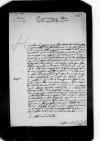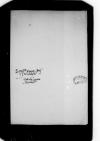List #871
Ioannes DANTISCUS do Sigismund I JagiellonLöbau (Lubawa), 1532-12-29
Rękopiśmienne podstawy źródłowe:
Pomocnicze podstawy źródłowe:
Publikacje:
| ||||||||||||||||||
Tekst + aparat krytyczny + komentarzZwykły tekstTekst + komentarzTekst + aparat krytyczny
 BNW BOZ TG 15 nr 1800, f. 207v
BNW BOZ TG 15 nr 1800, f. 207v
 BNW BOZ TG 15 nr 1800, f. 206r
Serenissima regia Maiestas, Domine et Domine clementissime. Humillimam perpetuae meae servitutis commendationem misi.
BNW BOZ TG 15 nr 1800, f. 206r
Serenissima regia Maiestas, Domine et Domine clementissime. Humillimam perpetuae meae servitutis commendationem misi.
Superiori die misi superinscribed⌈misimisi superinscribed⌉ ad illustrem
De
Quod reliquum est, me Serenissimae Maiestati suppliciter commendo. Christus, Dominus noster, det Serenissimae Maiestati Vestrae et istum novum et quam plurimos alios in diutissima salute et prosperitate transigere annum.
Ex
Serenissimae Maiestatis Vestrae humillimus capellanus et servus
[1] Written on piece of paper which is now lost
[2] in AT 14 the text follows: Scripsi hiis diebus Serenissimae Maiestati Vestrae non pauca, in quibus summopere cupio esse exauditus neque diffido, quin aliqua ex parte votis meis Serenissima Maiestas Vestra respondebit, praesertim in condonatione contributionis et in defensione contra

